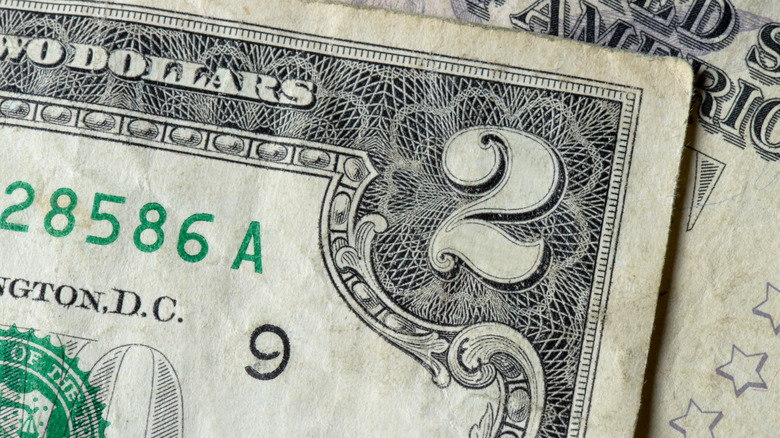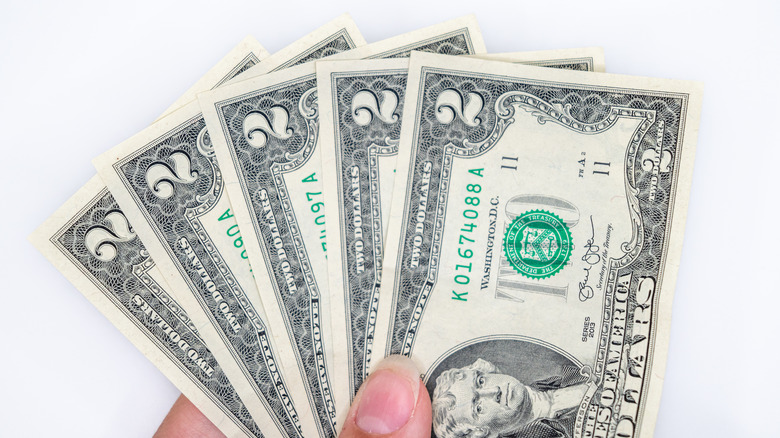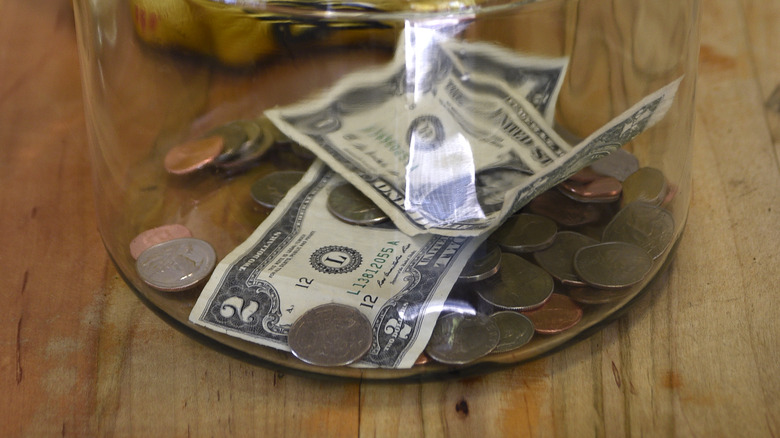The Real Reason They Stopped Regularly Printing $2 Bills
Pretty much everyone has heard hundred-dollar bills called "Benjamins" in pop culture, a nod to the portrait of Benjamin Franklin on the face, but did you know that the humble two-dollar bill has a monicker of its own? The $2 bill — which has been printed sporadically since 1862 — is nicknamed the "Tom" after Thomas Jefferson, who's on the face of all but the very earliest notes.
The $2 bill has been around since the inception of paper currency and since many Americans were earning less than $15 per month in 1862, it was actually considered a large denomination at the time. In 1966, the Federal Reserve ceased printing two-dollar bills due to low demand, only to bring it back again 10 years later for America's Bicentennial Anniversary in 1976.
It was thought that 1976's redesigned note with its beautiful images would rekindle the public's interest in using the two-dollar bill and lower the Treasury's printing cost versus producing double the number of one-dollar bills, but in reality, the opposite happened. Many citizens erroneously thought that the notes were a special limited edition and squirreled them away for collector value rather than transacting with them.
It was surrounded by negative publicity
There are several interesting theories about why the $2 bill never really caught on. The first involves an urban legend focused on rigging long-ago political elections. Apparently, the going rate for buying a citizen's vote was $2, so being in possession of a $2 bill was thought to have a negative connotation that its owner may have accepted a bribe. Similarly, in the 1920s, the going rate for "ladies of the evening" was $2, adding another layer of infamy to the innocent reserve note.
Finally, the word "deuce" is an old-timey nickname for the devil, leading many recipients to believe that a $2 bill would bring bad luck to its owner. To ward off an unfortunate fate, folks would tear off a corner of the notes to neutralize the stigma, leading to a raft of mutilated bills being culled from circulation as damaged. With the public rightly or wrongly shunning the bills, the government needed to recover the cost of printing them so it leaned on a captive audience: the military. For decades, the "Tom" was stuffed into armed forces' pay envelopes and circulated around military bases.
Old bills can be worth alot more than $2
As of 2020, there were more than 1.4 billion $2 bills still in circulation and most vending machines and self-checkout kiosks are programmed to accept them, even if they're not specifically labeled as such. In 2022, the Treasury was said to have printed up to 204 million brand new two-dollar bills based on a request from the Federal Reserve, so to paraphrase a quote from Mark Twain, the report of its death has been grossly exaggerated.
Nowadays, some very early bills are worth far more than face value. Certain 19th-century bills are valued at more than $4,500. Although finding such an old note in circulation might be next to impossible, more contemporary printings can still be worth hundreds. According to the US Currency Auctions website, an uncirculated note from 1995 can fetch $500, and a bill from a special 2003 Federal Reserve set is valued at a cool $700. So if you happen to receive an ol' Tom as change down at the local convenience store, it could be a wise move to do some sleuthing on the internet before spending it.


